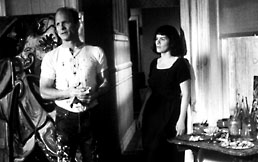go to WASHINGTON FREE PRESS HOME (subscribe, contacts, archives, latest, etc.)
Mar/Apr 2001 issue (#50)
|
|
Don’t Drink and Drip
by Jon Reinsch
To those who knew him, Jackson Pollock was already like a character in the movies. According to fellow artist Robert Motherwell, “he was so involved with his uncontrollable neuroses and demons that I occasionally see him like Marlon Brando in scenes from A Streetcar Named Desire—only Brando was much more controlled than Pollock.” Thus, it was only a matter of time until someone made a film of the painter’s life. Ed Harris, with Pollock, has now done so.
This earnest film is at its best when showing moments of artistic invention. One incident in Pollock’s life cries out for cinema: commissioned to produce a huge mural, he enthusiastically set up the canvas, but was understandably daunted by the magnitude of the task before him. For weeks he stared at it, unable to begin. Harris underscores the moment when he broke through his indecision—cutting between a blank screen and a closeup of Pollock’s eyes. I wonder, though, if the work was really completed overnight.
Another nice scene begins with the camera tracking Pollock through the snow to the barn he’d converted into a studio. There’s an almost ominous sense of something about to happen. We’re not disappointed; after starting up the stove, he discovers his technique of dripping paint onto a canvas lying on the floor. It seemed to me that Harris waited until this scene to adopt the pose, familiar from photographs of Pollock at work, in which a cigarette juts straight out of his mouth.
Undercutting such scenes are the cheap dramatics that follow. It seems likely that initial reactions to Pollock’s work were dominated by confusion. But here, people arrive at history’s judgment within seconds, proclaiming “genius” or “you’ve done it Pollock—you’ve cracked it wide open.”
Contrary to the spirit of Pollock’s work, the film is quite conventional in style, and it’s mostly up to the actors to provide insight. Portraying real people is a very different thing from playing a fictional character. An actor can hope to capture the essence of a Hamlet, because—in a sense at least—there is no Hamlet outside of the play. With a person who really lived, the actor’s aspirations are more modest—somewhere between a dead-on impersonation of speech patterns and gestures and creating a new fictional character with only a tenuous connection to the source.
Playing a verbally inarticulate artist presents special challenges. Harris (The Abyss, The Truman Show) gives us the full range of Pollock’s behaviors, from withdrawn and laconic to drunken violence. He takes such care to dim the light in his eyes that it’s striking on the rare occasions when he lets it shine through. As director, Harris highlights Pollock’s contradictions in a telling interview scene. As his halting responses continue on the soundtrack, the visuals shift to an overhead of him at work. The sureness of his movements contrasts with the diffidence of his words.
Amy Madigan (Field of Dreams) provides comic relief with her caricature of poodle-clutching art patron Peggy Guggenheim—complete with “special effects makeup.”
Marcia Gay Harden is racking up awards for her portrayal of artist (and Pollock’s wife) Lee Krasner. But I couldn’t get past the subordinate role she’s stuck with here, alternating between improbable little art history lectures (“That’s not cubism, Jackson!”), reporting on the developments in Pollock’s career, and telling him what a great painter he is. Upon meeting Krasner, Pollock tells her “You’re a damn good woman painter,” and the film’s treatment of her is almost as perfunctory. Her best moment comes when explaining why, after yet another explosion from her husband, she won’t “bring another life into that:” Pollock is all she wants, and all she can endure.
Harden fares far better than Jennifer Connelly, however. Astounding in last year’s unjustly neglected Waking the Dead, she’s here reduced to the role of Pollock’s lover. Fairly or not, this woman is depicted here as a frivolous art groupie, luring Pollock out of his fetal position and to his death.
What are the real villains of this story? Certainly demon rum was one. But opening with a shot of the Life magazine that made Jackson Pollock a household name, the film takes a skeptical view of celebrity. Pollock hungers for acceptance, but as he becomes a media darling, doing his “act” for photographers, he comes to wonder if he’s a phony.
As to what tormented the man all his life, what inspired him, and whether they were one and the same, Pollock is frustratingly silent. But there may be some meaning when, arriving at his country home, in quick succession he breaks down one door and smashes the lock on another. Each time he finds a mess inside. Those who “break the ice” in art may discover more than they bargained for.
